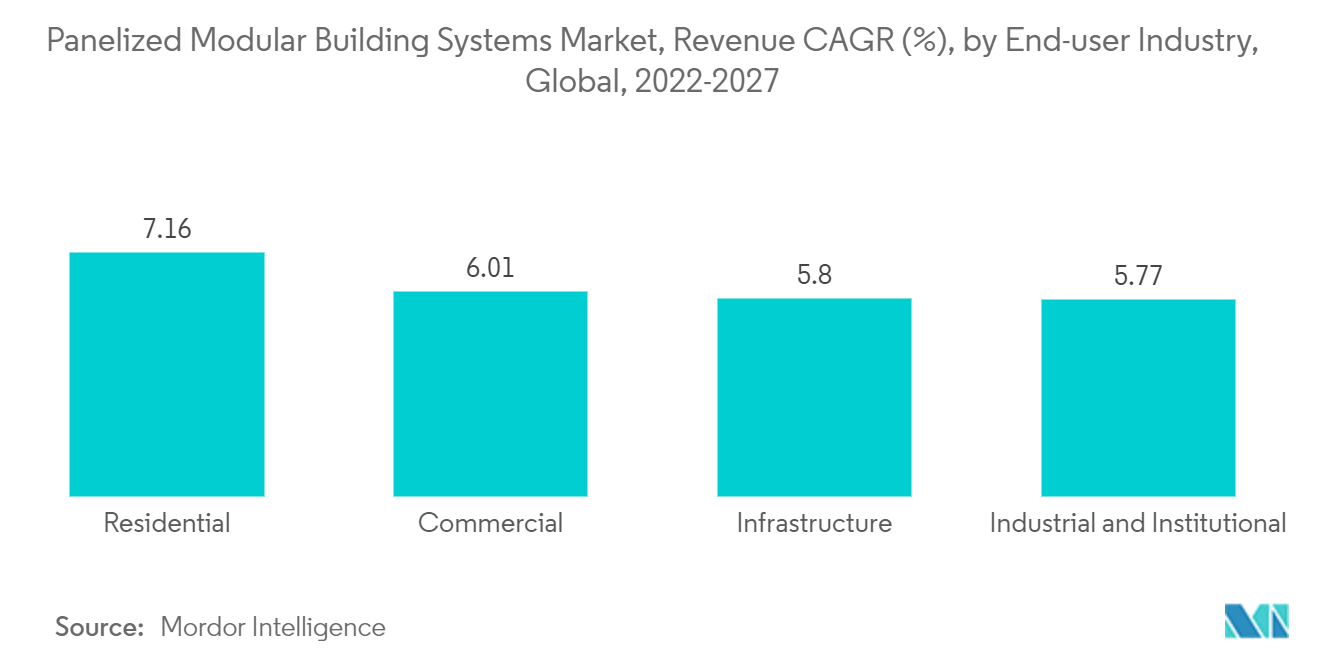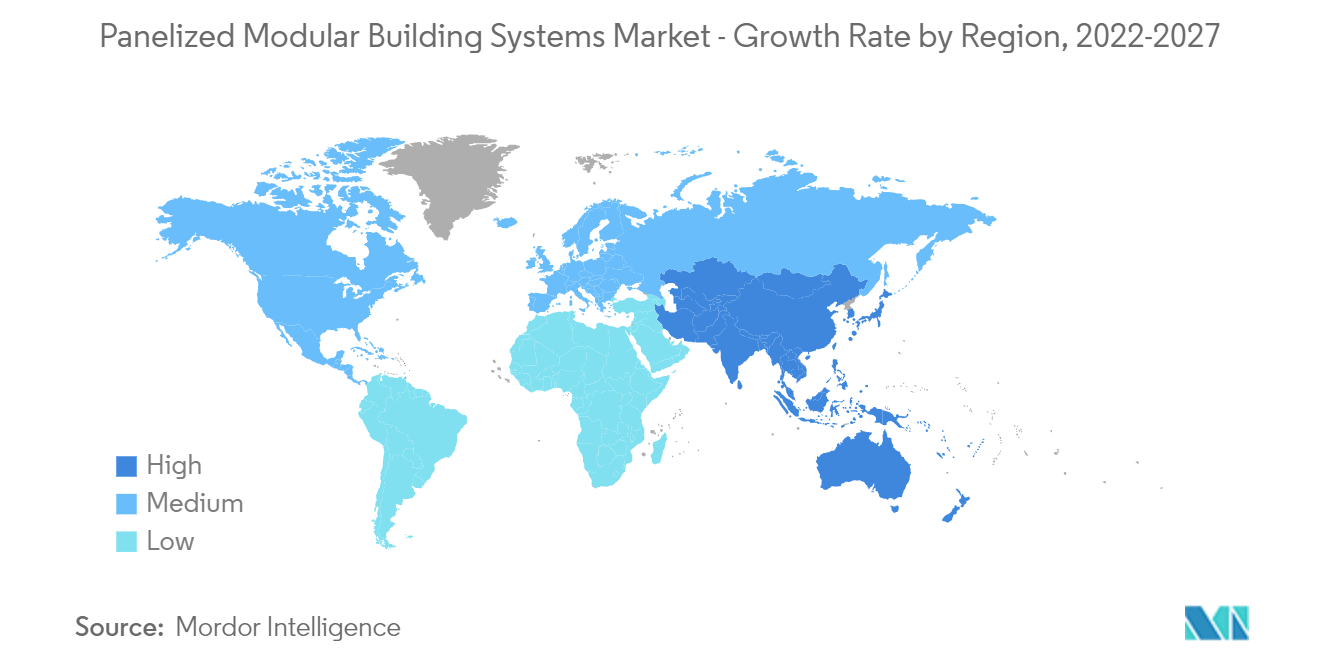Market Trends of Panelized Modular Building Systems Industry
This section covers the major market trends shaping the Panelized Modular Building Systems Market according to our research experts:
Residential Segment to Dominate the Market
- The residential industry is the primary end-user industry for the global panelized modular building systems market. These systems offer design flexibility and precision in building with controlled costs and reduced construction time. This advantage goes well with the growing demand for permanent housing and rising preference for a shorter delivery time of construction projects.
- Factors like minimized hassles due to reduced debris from home construction and demolition activities, home builders' continued pursuit of maintaining a profitable construction pace, and growing awareness toward the construction of energy-efficient residential places which are in perfect sync with the prefabricated construction practices are driving the market penetration of the panelized modular building systems in the residential segment.
- The rising number of migrants in the United States and European countries has increased the pressure on existing residential infrastructure. Hence, these countries, dwelling with advanced infrastructure and real estate spaces, are witnessing a gradual lead in reconstruction and renovation projects and new residential constructions.
- In 2022, the US government announced its plans to invest USD 3.16 billion to transform around 450,000 homes in low incomes areas to energy-efficient structures to cut down the country's utility bills.
- To cut down energy use and GHG emissions, the European Union policymakers, in 2021, have recommended renovations of all worst energy-rating buildings by 2030, keeping residential buildings on priority.
- In Germany, the new coalition government has planned to build 400,000 new housing units every year, of which 100,00 units will be publicly subsidized.
- China is the world's largest construction market. As China recovered from the pandemic doom, many residential constructions kick-started in the country. China's Evergrande Group has committed to building 600,000 homes in 2022. The housing authorities of Hong Kong launched several measures to push start the construction of low-cost housing. The officials aim to provide 301,000 public housing units in 10 years till 2030.
- India is likely to witness an investment of around USD 1.3 trillion in housing over the next seven years. It is likely to witness the construction of 60 million new homes. The availability of affordable housing is expected to rise by around 70% in 2024. The Indian government's 'Housing for All by 2022' is also a significant game-changer for the industry. This initiative which aimed to build more than 20 million affordable homes for the urban poor by 2022, has been extended to 2024 with a target of delivering 29.5 million pucca houses.
- Considering all the above facts and factors, the usage and demand of panelized modular building systems for residential construction applications are expected to grow in the forecast period.

Asia-Pacific Region to Dominate the Market
- Asia-Pacific dominated the worldwide market with a significant market share and is projected to maintain its dominance during the forecast period. The Asia-Pacific region, with low manufacturing costs, cheap labor sourcing, and a remarkably large customer base, has a substantial inflow of FDI, with India and China being the primary beneficiaries. The region's favorable economic climate has boosted demand for houses, hotels, shopping malls, high-rise buildings, and stadiums.
- As per the forecast given by the Ministry of Housing and Urban-Rural Development, China's construction sector is expected to maintain a 6% share of the country's GDP going into 2025. Considering the given forecasts, the Chinese government unveiled a five-year plan in January 2022 focused on making the construction sector more sustainable and quality driven. China plans to increase the construction of prefabricated buildings to reduce pollution and waste from construction sites. Further, the construction industry will be transitioning to modernized practices, establishing low carbon-production modes and improving the quality of buildings, consequently increasing the demand for panelized modular building systems in the country.
- Additionally, the Chinese government has rolled out massive construction plans, which include making provisions for the movement of 250 million rural people to its new megacities over the next ten years, creating significant scope for panelized modular building systems in the future.
- As per the Invest India Report, India's construction industry is heading to reach USD 1.4 trillion market size by 2025, supported by schemes about the smart city mission targeting the transformation of 100 cities and affordable housing. Under National Investment Promotion, India has an investment budget of USD 1.4 trillion on infrastructure - 24% on renewable energy, 19% on roads and highways, 16% on urban infrastructure, and 13% on railways.
- Japan is a significant area in the field of skyscrapers and high-rise buildings. Many luxury apartments and residential complexes are under construction in Japan. For instance, Mitsubishi State is constructing Japan's tallest building, comprising 50 luxury apartments, each generating USD 43,000 monthly rent. The project is being built near the Tokyo station and will reach completion by 2027.
- The South Korean government has outlined its plan to execute large-scale redevelopment projects to supply 830,000 housing units in Seoul and other cities by 2025. From the planned construction, Seoul will get 323,000 new houses, and 293,000 will be built near Gyeonggi Province and Incheon. Significant cities like Busan, Daegu, and Daejeon will also benefit with 220,000 new houses in 4 years.
- All factors above are likely to fuel the growth of the panelized modular building systems market in Asia-Pacific over the forecast period.

